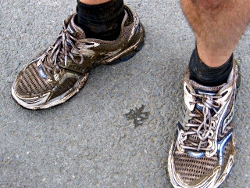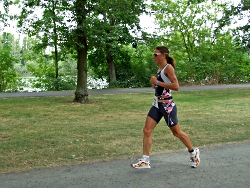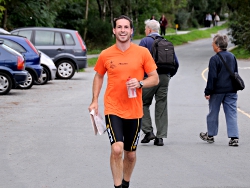SYNOPSIS: This article is designed to take the amateur runner from doing the occasional half hour jog after work or once-a-year half marathon, to running their first Ultra Marathon. It is not a rigid, day-by-day training plan (because I don’t think you need one) and it probably won’t help you run one quickly (because I can’t do that myself). But, it will tell you everything you need to know to start running long distance, cheaply and easily.
My Experience
I am not an expert ultra marathon runner. A few years ago I had never run more than 16 miles. But, since then, I have run a half dozen or more “ultra marathons”, 30, 45, 50 miles at a time.
In 2010 I ran the length of every London Underground Tube line, sometimes starting outside of the M25 in a cow field, running all the way into central London, and out to Zone 6 on the other side. In 2011, after discovering that nowhere in the UK was more than 70 miles from the sea, I left my London flat in my running shoes and kept going until I hit Southend, 50 miles later.
What I offer here is the view of someone who has recently started running longer distances and what I’ve learned from my experiences so far. Here is my advice…
1. Get Your Head Straight
First off, stop calling it an ultramarathon. That’s a silly name that belongs in the same dictionary as “extreme” sports and “Iron Man” triathlons. If you build it up in your head then you’ll make it harder for yourself. There is nothing qualitatively different between running 26.2 miles and running 30 miles, 50 or more. It’s just a bit longer and the sooner you realise that, the sooner you can get on with the real preparations.
Secondly, don’t conflate running a long way with having to do so quickly. If you have to stop and re-tie your shoe laces after the first mile, sit down for five minutes to eat a sandwich or take half a dozen loo stops on your way then do so and don’t fret about it. Taking a few extra minutes or hours won’t matter one shred when you cross the finish line.
If you’re into timings then you can work on your speed once you’re comfortable with the distance, but don’t make it hard for yourself by trying to do both at once.
2. Train (but not too much)
You’ll be pleased to hear that you do not need to train seven days a week in a gruelling regime to complete a long run. In fact, you could go from start to finish without ever losing your breath. It’s about endurance, not speed. The key is to gradually increase the number of hours you spend on your feet running, walking and generally being active. It is not to bust a gut on a treadmill set to max speed.
With a gun to your head, you could probably run 30 miles or more right now but it would likely not be very good for your body. The aim of training, therefore, is to improve the ability of your legs and the rest of your body to endure prolonged usage. The rest of it will fall into place. And there is simply no better way to do this than to slowly increase the distance and duration of your runs but you can mix that up with long walks and faster sessions if you fancy it, and anything else that will keep you interested and moving.
Whether you run five times a week or once, you can still get there. Just build up slowly, push your distance not your speed, and give yourself plenty of rest inbetween sessions.

3. Get Comfortable Kit
Shoes, shorts, top and maybe a small bag. There’s not much else you need and the key with kit is that it’s comfortable.
People will say you should get a “good pair of running shoes”. To me, that means ones that fit well and feel comfy – nothing more, nothing less.
The clothes you run in don’t need to do much besides keep you from getting too hot or too cold and irritate you as little as possible. I use a pair of lycra cycling shorts I got in a sale five years ago and either a wicking top (one that gets rid of sweat quickly) on cold days or an old t-shirt on warmer ones.
You might want to run with a small bum bag or rucksack if you don’t have a regular support team or stops. It’s worth getting a bag designed for running because it’s likely to be more comfortable but that needn’t be expensive (my first one cost £18 from Millets).
4. Make as Little Effort as Possible
There is no special way you need to run just because you’re going further than normal but it pays to minimise effort. The emphasis is on efficiency, not speed and thus the best technique for running long distance differs quite a lot from the one you might use to catch a bus.
It’s more like a shuffle. Your feet hardly need come more than an inch off the ground and your knees not more than an inch in front of you. Your arms can hang down by your side and move back and forth a little but you needn’t pump them like Usain Bolt. These may seem like minor adjustments but when you’re running all day long, every bit of energy saving will be appreciated.

5. Eat and Drink What You Like
I’ve fueled all of my runs on cheap food from supermarkets and, mostly, tap water. Do not assume that just because it’s a bigger run than that you need some kind of fancy nutritional supplements. You don’t.
Your three requirements are fluids, calories and minerals.
Fluids
There is no secret to getting fluids on board: You can simply drink water. Squash is good too as is dilute fruit juice. Sports drinks are fine as well but by no means necessary. Just drink anything watery of which you like the taste. And make sure you continue to drink throughout the run, whether you feel like it or not.
Calories
Where possible, try to get most of your calories from slow release carbohydrates like dried fruit, bananas, flapjack and nuts (look for the ‘Low GI’ label in supermarkets). They’ll help you avoid too many spikes and troughs in your energy levels. Remember, you are in this for the long haul so whilst you may be craving an entire block of chocolate or feel the urge to suck down an energy gel, you may regret it ten minutes later when you have a slump in energy.
But don’t get too hung up on special foods. If you hate dried fruit and bananas make you gag then don’t eat them. Snacks on my runs have included cheese baguettes, Quorn sausage rolls, a large block of marzipan and a lamb samosa. It’s worth bearing in mind the release rate of what you’re eating but when you’ve been running for 4 hours/8 hours/more, sometimes you’ve just got to give your body whatever it’s asking for. Even if that’s a lamb samosa.
Minerals
When you’re running for this long, you will need to replace salt and other minerals lost through sweat; primarily magnesium, calcium and potassium. You’ve probably heard about this sort of thing through sports drinks adverts but they’re not actually the best way to get what you need (they rarely contain enough salts and often add lots of unnecessary ingredients).
To get these minerals you can add sea salt to your drinks (if you can taste it, you’ve added too much), use Dioralyte, Nuuns or similar, or just rely on your food for it. Each of the food stuffs I mentioned above – dried fruit, bananas, flapjack, nuts – are good sources.
So whilst it’s fine to eat chocolate, cheese sarnies or energy bars, you need to do so alongside other food and drink that will replace your minerals and keep your body functioning efficiently.
[For more on this topic, see How To: Use Supermarket Food for Sports Nutrition]

6. Keep Moving
After the first mile or two of running, it’s worth taking the time to do a few warm-up exercises. Not necessarily stretches but more like the stuff you used to do in PE: side stepping, kicking your heels up, lunging and such like. These will help avoid muscles seizing up and becoming uncomfortable after many hours of running.
I always try to throw in a few of these exercises every few miles or so, just to keep my muscles loose. Run for 10 hours in the same position and you can bet that the unused muscles will feel stiff at the end of the day. You may find stretching out certain muscles helps too and, contrary to the bit above about efficiency, it’s worth varying your running style every so often to engage and rest different muscles.
Also, although it’s tempting to sit or even lie down when you stop for a break, don’t do it for too long. Apart from the increased mental effort of starting again, your muscles won’t appreciate it. Try to at least pace around every minute or two.
7. Treat Yourself Well
And when it’s all done and you finally stop running, be sure to look after yourself. You won’t collapse in a heap, gasping for air like Roger Bannister after 4 minutes on the track but that’s just because it’s a different kind of exertion and you need to treat yourself accordingly.
Eat a lot and drink even more. Stretch out and keep your legs moving. Not just immediately afterwards but, in both cases, for the next day or two. If you find yourself walking awkwardly from stiff muscles, unless it’s genuinely painful, try to make yourself walk as naturally as possible. It will help loosen your muscles up and avoid strange looks from passers by.
But before any of that, lower yourself into as cold a bath of water as you can get your hands on. Maybe throw in some bags of ice. This might sound masochistic but it’s anything but. You’ll quickly get used to it and the feeling when you get out is divine.
(Thanks to Rob Cousins for his help with this article, both direct and indirect)

What do you think? Please do add your thoughts below…